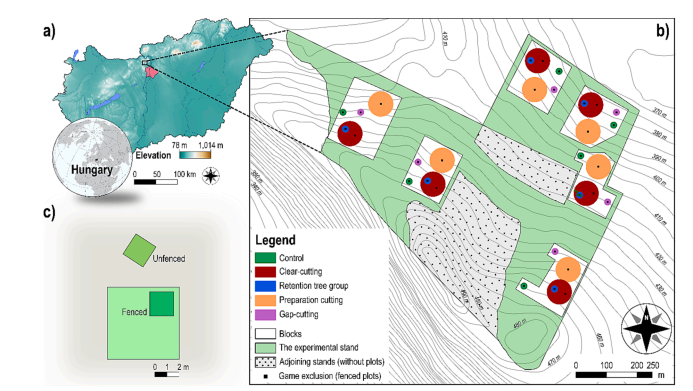- Szerzők: Aszalós Réka, Kovács Bence, Tinya Flóra, Németh Csaba, Horváth Csenge Veronika, Ódor Péter
- Megjelenés: 2023.12.01. FOREST ECOLOGY AND MANAGEMENT 549 Paper: 121438 , 15 p. (2023)
- MTMT azonosító: 34154709
Absztrakt: Forest management has a major impact on the understorey vegetation, with the intensity and type of the applied silvicultural treatments driving variable vegetation responses. We compared understorey variables across different experimental silvicultural treatments in a temperate oak-hornbeam forest in Central Hungary. Five treatment types were used in six replicates representing rotation and selection silvicultural systems: control (C), clear-cutting (CC), gap-cutting (G), preparation cutting (P), and retention tree group (R). The response of several understorey variables was investigated to the treatments in the first six years after their implementation in 2014. We assessed how understorey variables change in response to different forestry treatments, how these responses vary with time, and how game exclusion affects them. We then evaluated how well the treatments can preserve the forest character of the vegetation. We found a large temporal variability in the understorey variables over the study period. In all cases, the interventions led to an initial increase in species richness, followed by a decline later, where the regeneration layer started to close. The regeneration layer grew most intensively in G and CC. At the end of the study, R had the highest average species number, comprising a heterogeneous group of perennial forb species. The interventions all resulted in a rapid increase in total herb layer cover, mainly in favour of graminoid and perennial species. The extent of cover increase depended primarily on the amount of additional light received (CC > G > P > R > C). Turnover and beta diversity values also decreased in a similar order. The effect of game exclusion was especially pronounced in the case of the CC and G, where game browsing significantly slowed the regeneration outside the fences. The most significant changes in almost all variables were in the CC. It had the highest number of indicator species, many of them annual, disturbance-related, and invasive. G preserved the forest character of the vegetation better and proved to be less susceptible to the mass appearance of disturbance-related and invasive herbaceous species. Increasing the share of continuous cover forestry methods is crucial to preserve the forest herb layer. Rotation forestry with large cutting areas is not recommended or should be kept at low landscape rates, as these areas are highly exposed to disturbance-related and invasive species. Leaving retention tree groups can be key to the survival of numerous forest plant species.



